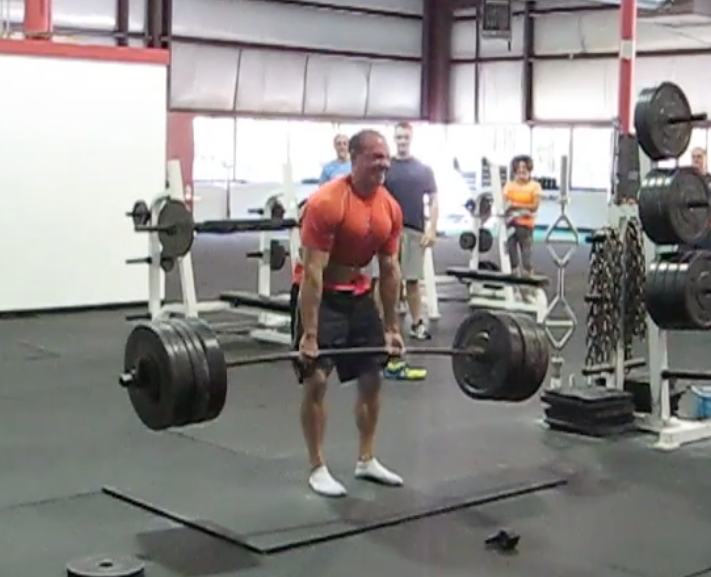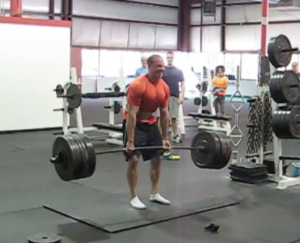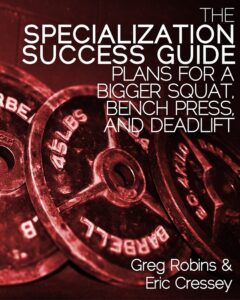
Frequent Pulling for Faster Progress: 12 Weeks to a Bigger Deadlift
The deadlift is the bastard child of powerlifting; it doesn’t get much love. Maybe it’s the fact that the deadlift is less impacted by equipment than are the squat and bench press, so it may require less practice. Or, it might just be vilified because lifts 7-9 of a powerlifting meet feel like cardio after a long day of lifting. Finally, it may be that many lifters and coaches hold that the deadlift is best trained indirectly, and that the chips will just fall into place if you focus on squats, good mornings, and plenty of assistance work. While this may be the case in some instances, there are also quite a few lifters who have made tremendous progress with more frequent pulling, and that’ll be my focus in this article.
Up until this past July 30, I was a member of the “leave it alone” crowd. All that changed between August and November of this year, though. Going into AWPC Worlds this past summer, my best pull was 556.5 at a body weight of 163. It’s not a tremendous pull, by my own admission, but it was good enough for a Powerlifting USA Top 50 ranking. In preparing for Worlds, I had what I thought was a very productive training cycle; both my squat and bench felt great, and I expected the pull to just come along for the ride and magically improve. I couldn’t have been more wrong.
I wound up going out and pulling 567.5 at 164. It was a PR, but I was anything but content with it. Very simply, I felt like crap when the time came to pull. In my mind, there was no excuse for me to not be ready when the time came – especially as a lightweight (who are expected to recover faster between lifts than their heavier counterparts). My opener should have been speed weight, but it came up slower than expected.
My second attempt (567.5) was a good six-second grinder. At this point, I was completely gassed; I practically needed a hit of ammonia just to get out of my chair and up to the platform for attempt #3. Needless to say, I missed the lift after getting it to about mid-shin; I didn’t have anything left to grind it out. In spite of taking home the junior lightweight best lifter trophy, I beat myself up on the inside for the entire flight home from Chicago that night. This flight actually turned out to be one of the most productive two hours of my training career, though, as I mapped out my plan for the subsequent 12-week training cycle.
The end result? A 6% improvement in 12 weeks; I wound up pulling an easy 601 on my third attempt in November, leaving a good 15-20 pounds on the platform – all after setting PR’s on my squat and bench press. So, it wasn’t inconceivable to think that the template I outline below added 10% to my pull in a single 12-week training cycle.
Outlining a Solution
There are seven basic tenets for the program:
1. On the whole, pull more frequently. Specificity of training is more important than you think; it takes practice to fine-tune your set-up and movement execution.
2. Pull for speed after your dynamic effort squats for the first three weeks of the month.
3. During these three weeks, your first assistance exercise on max effort squat/deadlift day should be a deadlift variation.
4. In the fourth week of each month, your max effort squat/deadlift movement will be a deadlift variation in order to allow you to monitor progress. The other three weeks should be squat and good morning variations.
5. Learn to pull in a state of fatigue – which is exactly what happens in competition.
6. Make sure to do your DES/D session before your MES/D session in the weekly training split. For example, I do my dynamic work on Sunday morning and my max effort work on Wednesday night.
7. Overall training stress – a function of volume, intensity, exercise complexity, and a number of other factors – should be fluctuated from week to week using the following format: high, medium, very high, low.
I’ve made some modifications to suit the unique needs of different lifters. As a lifter whose sticking point is at lockout, I focus more on accommodating resistance. Lifters who tend to have problems off the floor would be best off with pulls from a deficit, as I’ve noted in parenthesis to allow you to modify the program as needed. Keep in mind that the pulling below was just one component of my program; I was also doing squat and good morning variations, GHR’s, single-leg movements, and plenty of core work.
12 Week Deadlift Program
Week 1: High Volume
Dynamic Effort – DES/D: Speed Pulls vs. Bands (if you’re weak off the floor, perform these while standing on a 2-4” step and eliminate the bands). Bar Weight = 50%, 10 sets of 1.
Max Effort – MES/D: First Assistance Movement: Snatch Grip Deadlifts (wearing straps is fine). 3 sets of 4 (work up to them; they should be heavy).
I used a controlled bounce between reps, as I am weak at the top. Those who are weak off the floor should pause between reps.
Week 2: Medium Volume
Dynamic Effort – DES/D: Speed Pulls vs. Bands (if you’re weak off the floor, perform these while standing on a 2-4” step and eliminate the bands). Bar Weight = 55%, 8 sets of 1.
Max Effort – MES/D: First Assistance Movement: Snatch Grip Deadlifts (wearing straps is fine). 2 sets of 3 (work up).
Same guidelines as noted above.
Week 3: Very High Volume
Dynamic Effort – DES/D: Speed Pulls vs. Bands (for those who are weak off the floor, perform these while standing on a 2-4” step and eliminate the chains). Bar Weight = 60%, 12 sets of 1.
Note: These last few sets shouldn’t feel much like speed in light of the higher percentage of 1RM, considerable band tension, and accumulated fatigue.
Max Effort – MES/D: First Assistance Movement: Snatch Grip Deadlifts (wearing straps is fine). 4 sets of 4 (aim to use work weight from week 2).
Same guidelines as noted above.
The goal with week three is to dip into your reserves considerably, so a run-down feeling is to be expected at week’s end and into the first 4-5 days of week 4. Remember that fatigue masks fitness; the idea is to deload considerably in the early part of week 4 so that your system will recuperate to the point of being able to demonstrate its true fitness by later in the week – when you’ll test your max.
Week 4: Low Volume
Dynamic Effort – DES/D: No pulling (easy day).
Max Effort – MES/D: Main Movement should be a deadlift variation (e.g. competition pull, altered stance, reverse band deadlift, deadlift against bands/chains, or deadlift from a deficit).
Omit first assistance movement (Snatch Grip Deadlifts) from weeks 1-3.
Week 5: High Volume
Dynamic Effort – DES/D: Speed Pulls vs. Chains (for those who are weak off the floor, drop one set of chains and perform these while standing on a 2-4” step). Bar Weight = 55%, 10 sets of 1.
Max Effort – MES/D: First Assistance Movement: Rack Pulls (just below kneecaps for those with lockout problems; mid-shin height for those who are weak off the floor). 3 sets of 5.
Week 6: Medium Volume
Dynamic Effort – DES/D: Speed Pulls vs. Chains (for those who are weak off the floor, perform these while standing on a 2-4” step and eliminate the chains). Bar Weight = 60%, 8 sets of 1.
Max Effort – MES/D: First Assistance Movement: Rack Pulls (just below kneecaps for those with lockout problems; mid-shin height for those who are weak off the floor), 3 sets of 4.
Same guidelines as noted above.
Week 7: Very High Volume
Dynamic Effort – DES/D: Speed Pulls – no chains, from the floor (regardless of your weakness). Bar Weight = 65%, 12 sets of 1.
Max Effort – MES/D: First Assistance Movement: Snatch Grip Deadlifts, 4 sets of 5 (aim to use weight from week 6).
Same guidelines as noted above.
Here, we’re still imposing a significant amount of fatigue, but we don’t want any spillover to the last deadlift test (end of week 8) prior to the meet. As such, we’ve swapped bands for chains, eliminated accommodating resistance altogether in week 7, and limited the total work done on our assistance deadlift movement (less distance to pull with rack pulls). You’ll still probably feel run-down, but it shouldn’t be as bad as it was after week 3.
Week 8: Low Volume
Dynamic Effort – DES/D: No pulling.
Max Effort – MES/D: Last Heavy Pull – Competition Deadlift test (with or without suit, depending on how you pull). As a general rule of thumb, the last heavy pull should be no less than 21 days out from competition. I go with four weeks to err on the side of caution.
Week 9: High Volume
Dynamic Effort – DES/D: No Pulling.
Max Effort – MES/D: Speed Pulls – No Accommodating Resistance (test with suit, if you wear one). Bar Weight: 55%, 8 sets of 1.
Week 10: Medium Volume
Dynamic Effort – DES/D: No Pulling.
Max Effort – MES/D: Speed Pulls – No Accommodating Resistance. Bar Weight: 50%.
Week 11: Very High Volume
No Pulling.
Week 12: Rest End of Week 12
Meet.
Closing Thoughts
Regardless of why so many powerlifters place it on the back burner, the fact remains that the pounds accumulated on the deadlift count just as much as those amassed on the squat and bench press. Sure, thousands of lifters have seen great results by avoiding deadlifts, but that’s not to say that there aren’t thousands more who can benefit tremendously from more pulling; there is more than one way to skin a cat. If you’re searching for a new strategy – especially if you notice you’re dragging when lifts 7-9 roll around on meet day – give this template a shot and let me know how it works out for you.
Note: if you’re looking for more options for specializing on certain lifts over the course of a powerlifting training cycle, I’d encourage you to check out The Specialization Success Guide, which includes detailed plans to bring along the squat, bench press, and deadlift.




